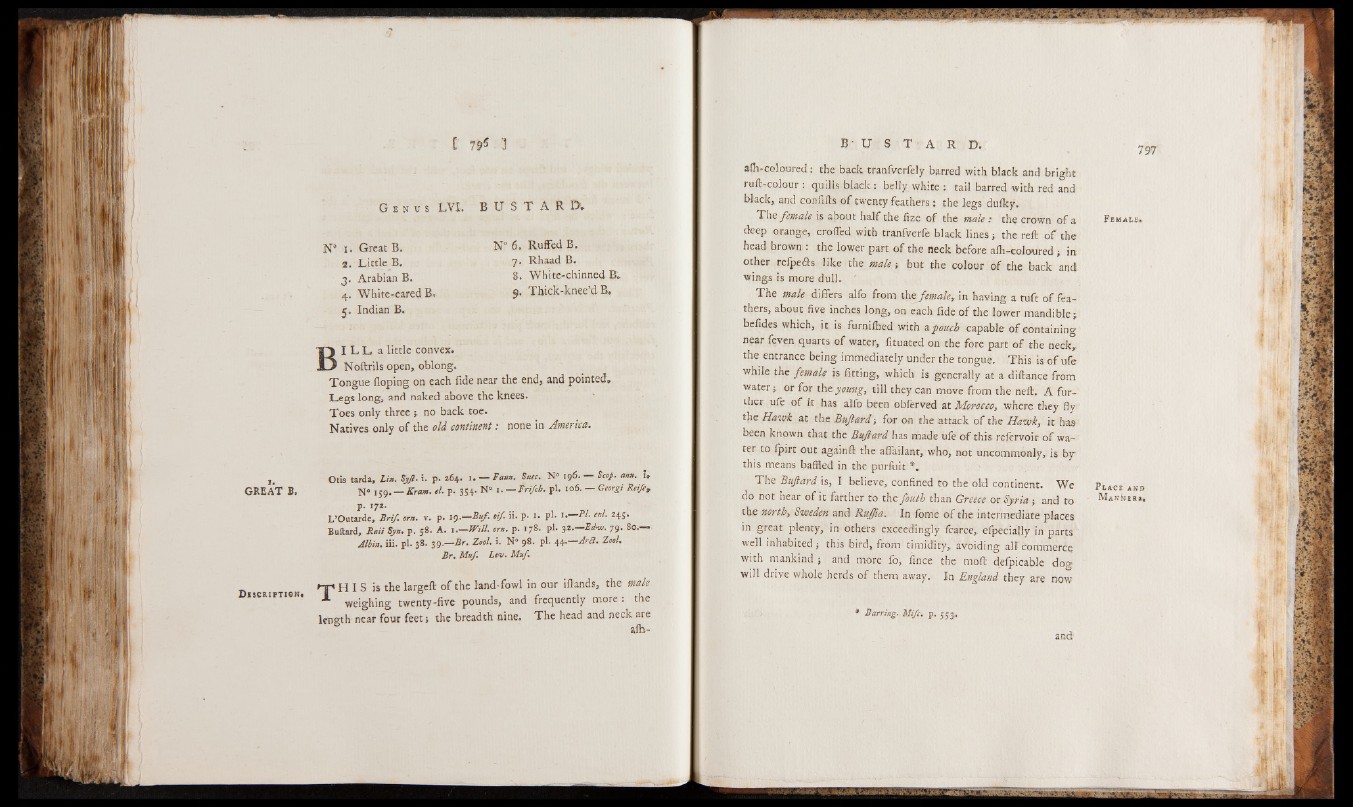
C 7 i 5 3
i. GREAT B.
D i s c r e t io n .
G e n u s L Y I . B U S T A R D *
N° i » Great B.
2. Little B.
3. Arabian B.
4. White-eared B.
j . Indian B.
N° 6. Ruffed B.
7. Rhaad B.
8. White-chinned B.
9. Thiclc-knee’d B.
BI L L a little convex.
Naftrils open, oblong.
Tongue floping on each fide near the end, and pointed.
Legs long, and naked above the knees.
Toes only three 5, no back toe.
Natives only of the old continent: none in America.
Otis tarda, Lin. Sjff. i. p. 264. 1. — Faun. Suec. N° 196. — Scop. aim. 1,
N« 159. — Kram. el. p. 354. N° 1 . — Friffb. pi. 106. — Gcorgi Rtife,
p. 172.
L’Oatarde, Brif. orn. v. p. 1 <).— Buf. oi/.ii. p- 1. pi- l.— PL ml. 245.
Buftard, Rail Syn. p. 58. A. i .—Will. on. p. 178. pi. 52.— Fdvi. 79. 80.—
J ilin , iii. pi. 38. 39.— Br. Zool. i. N° 98. pi. ^ .— Arll. Zool.
Br. Muf. Lev. Muf.
f-ri H I S is the largeft of the land-fowl in our iflands, the wale
weighing twenty-five pounds, and frequently more: the
length near four feet j the breadth nine. The head and neck are
afht
m
B U S T A R D.
afh-coloured: the back tranfverfely barred with black and bright
ruft-colour : quills black: belly white ; tail barred with red and
black, and confifts of twenty feathers ; the legs dulky.
The female is about half the fize of the male: the crown of a
deep orange, eroded with tranfverfe black lines j the reft o f the
head brown : the lower part of the neck before alh-coloured j in
other refpefts like the male-, but the colour of the back and
wings is more dull. '
The male differs alfo from the female, in having a tuft of feathers,
about five inches long, on each fide of the lower mandible*
befides which, it is furnilhed with a pouch capable of containing
near feven quarts of water, fituated on the fore part of the neck°
the entrance being immediately under the tongue. This is of ufe
while the female is fitting, which is generally at a diftance from
water* or for they^«^, till they can move from the neft. A further
ufe of it has alfo been obferved at Morocco, where they fly
the Hawk at the Buftard-, fo-r on the attack of the Hawk, it has
been known that the Bujlard has made ule of this relervoir of water
to fpirt out againft the afiailant, who, not uncommonly, is by
this means baffled in the purfuit *.
The Buftard is, I believe, confined to the old continent. We
do not hear of it farther to the fouth than Greece or Syria -, and to
the north, Sweden and RuJJia. In fome of the intermediate places
in great plenty, in others exceedingly fcarce, efpecially in parts
well inhabited -, this bird, from timidity, avoiding all commerce
with mankind ; and more fo, fince the mod defpicable dog
will drive whole herds of them away. In England they are now
797
Female*
Place and
Manner»«
ŸM
ï'tikmÊ
* v m \
m n
jjggflg
* Barring. Miff. p. 5.5.3.
and